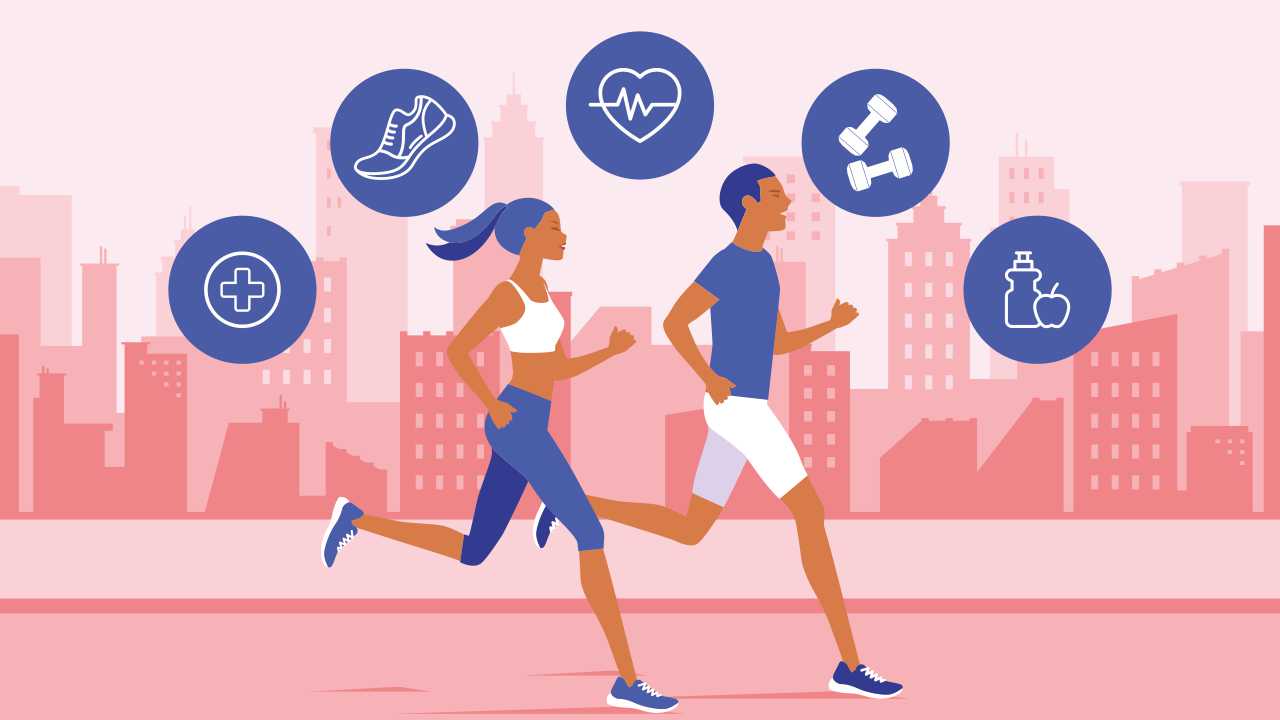
Running Tips for Beginners

Running is a simple sport; all you need is a pair of shoes, and you are good to go. Along with being fairly easily accessible, running can also do wonders to your health. It has many cardiovascular benefits and can boost bone health.
If you are new to running, learning a few basics will help you be prepared and progress wisely on your journey. These running tips for beginners will help you get going in the right direction.
1. Get medical clearance
Starting any new physical activity is often beneficial. However, it is advisable to check with your doctor before beginning a running program if you have been dealing with a medical condition or are under certain medications. Also, if you have been sedentary for a while or were dealing with an injury, it is important to begin gradually and take your doctor’s approval for any specific guidelines.
For example, people who have diabetes are recommended to review their blood sugar levels before a workout and ideally wait for two to three hours after a meal to stabilize their blood sugar levels. Additionally, you can fill in your details in the Physical Activity Readiness Questionnaire (PAR-Q). It is a self-screening questionnaire to determine any potential health risks associated with exercise based on medical history, current symptoms, or any risk factors.
2. Select appropriate shoes
Running shoes are designed to protect your feet by providing optimum cushioning and absorbing the shock of impact every time your foot strikes the ground. Remember, your running shoes should not only be comfortable, but they must also fit according to your feet type and pronation. Additionally, here are some important factors to consider, which might affect your fit while selecting your running shoes:
- Buy shoes towards the end of the day; it is because your feet tend to swell through the course of the day
- Opt for running shoes, which are half a size bigger than your shoe size. Your toes should have room to wiggle, and your longest toe should have a thumb’s space from the front of the shoe.
- Try running shoes while wearing your usual running socks. Depending on your preference, the padding of the socks could be thin or thick and this can affect the shoe fit.
- Make sure the fit is snug but not tight enough to cause discomfort. Stand and walk around in the shoes. Check the inside of the shoe for any rough spots or seams that may cause blisters.
Also read: Running Shoes: Your Guide to Getting Started
3. Choose appropriate apparel
For many, the first choice of material for clothing is cotton. Although cotton is a comfortable fabric, it retains moisture and sweat, leading to loss of breathability. In addition, it may cause chafing. So, it is best to avoid 100% cotton and instead wear running-specific clothing that has moisture-wicking property — this means that such clothing will not retain moisture. These are made of light-weight, high-performance materials, such as polyester or nylon, which moves sweat away from the body to the fabric surface, where it evaporates.
It is recommended to dress as light as possible after evaluating the weather conditions. When it is warm, a pair of shorts and a T-shirt made of breathable fabric is all that you require.
Women should wear sports bras while running. It is because this activity involves an increased motion and bounce of the breasts, which can cause pain and discomfort. Opt for sports bras that provide maximum support, limit movement, and prevent any breast pain during runs. The bra should be firm and hold the breast close to the body. Moreover, it should have non-slip, non-stretch straps and no irritating seams or fasteners sitting next to the skin.
Also read: Running Clothes: Your Guide to Getting Started
4. Take safe training routes
Your choice of route should be a safe one. However, do not train on isolated routes in case you need help for an emergency. Adhere to these rules to enjoy a risk-free and safe run:
- Run against the direction of traffic. This way, you are cautious of any vehicles that may be coming towards you.
- Pay attention to the oncoming traffic and cars coming up fast behind you
- Run on the shoulder and not on the main road
- Avoid running when it gets dark; however, if you do so, then wear clothing that has reflective stripes
- Run on well-lit and densely populated routes and not in deserted areas
- Keep the volume on low or disable noise-cancellation features if you are running with music so that you are alert of your surroundings
5. Start with the run-walk method
The run-walk method is an effective technique for improving endurance for a beginner runner. As a beginner, you may not have the aerobic capacity to sustain running for a prolonged period. The run-walk method helps you to take periodic breaks by alternating between running and walking. When you start with the run-walk method, focus on being on your feet for a total duration of 30 minutes. This does not mean that you need to be running for the entire duration. You can split your time by running for 1 minute, followed by walking for 1 minute. Here, you may consider a minute of running followed by a minute of walking as one set, which will last for 2 minutes. You can repeat this set 15 times to complete 30 minutes of total workout. You can keep this as your base and slowly progress by increasing the running time.
Also read: How to Get Started with the Run–Walk Method
6. Monitor intensity
When you begin training, the intensity should be that of an easy pace. One way to do this is to train based on effort level. Your effort level is indicative of how you feel from within while training. Running at an easy pace or a conversational pace is when you can run while carrying a full conversation without getting out of breath. In case the effort of your run makes you breathe harder or go out of breath, it means you are not sticking to an easy pace and need to slow down. The Borg Rate of Perceived Exertion (RPE) scale, as seen in the figure below, can be used for rating exertion during physical activities. Although this is a subjective scale, it allows you to focus on effort level and can serve as a guide to track how each run feels.

Also read: Pace or Effort-based: What Is the Right Strategy for Running?
7. Practice progressive overload
Progressive overload means you gradually increase the load or the stress placed upon the body. It suggests that the continual and slow increase in the total workload during training sessions will result in gains in endurance and help you progress safely.
In activities, such as running, the initial period of training is focused on building your aerobic fitness. An effective and safe way to do this is to slowly raise the training volume while keeping the intensity low. In endurance sports, a common metric used for progression is the 10% rule. This is the technique of increasing your training volume by no more than 10% weekly. The main goal behind this technique is to help you progress safely and minimize the risk of overtraining.
Also read: Science of Progression: How to Improve Consistently
8. Maintain a logbook
The goal of training should be to get better at running. A way to do this is by keeping a detailed logbook of your training. The logbook should have comprehensive data that you can use to analyze your performance. Some essential details to include in your logbook are:
- Date and time of workout
- Type of workout
- Record of your resting and maximum heart rate
- Weather conditions
- Duration
- Distance
- Effort level on a 1–10 scale based on RPE
- Details of hydration and nutrition before, during, and after your run
All this information will be useful when you review the history of your runs. You will then be able to modify certain factors in your training that can help improve your performance.
9. Incorporate strength and flexibility training in your exercise regime
As a runner, your primary focus may be on accumulating more mileage. However, running is a high-impact sport, ie, your joints and muscles have to endure high levels of stress. This makes it important to have strong muscles to sustain the impact to reduce the risk of running-related injuries.
Often, running injuries happen due to overuse. Studies show that including strength training in your routine will help you maintain good posture and gait while running. Moreover, it will aid you in preventing injuries, improving muscle power, and building lean mass.
Also read: Running for Beginners: Can Strength Training Help Prevent Injuries?
Also, with rigorous training in running programs, there is often a decrease in range of motion in areas, such as the hips, glutes, calves, hamstrings, and ankles. These areas may become tight as a response to training. So, a combination of flexibility and mobility should also be a part of your running workout plan.
10. Focus on nutrition and hydration
As a runner, you have to fuel properly to deliver the best performance and ensure optimum recovery. Carbohydrates (carbs), proteins, and fats are the three building blocks of an endurance athlete’s diet. So, most of your meals should have these components. It is important to eat a wholesome diet comprising whole grains, fruits, vegetables, dairy, protein, and healthy fats.
Ensure that you eat a small carb-rich snack at least 30 minutes before your run. While running, drink adequate quantities of fluid or electrolyte, depending on the weather, to avert the risk of dehydration.
It is suggested to consume at least 125ml-250ml of water every 15-20 minutes during your workout. After every run, it is important to have a meal rich in healthy carbs and protein to initiate the recovery process. Also, focus on re-hydrating your body after you finish your workout. A way to assess your hydration status is to check the color of your urine; if it is pale in color, it is indicative of proper hydration.
Also watch: Nutrition for Beginner Runners
These are some of the running training tips for beginners that you should keep in mind. As you begin to run and progress in your journey, following these ideas will help you decrease the risk of injuries, and you will evolve as a better runner in the long run.














